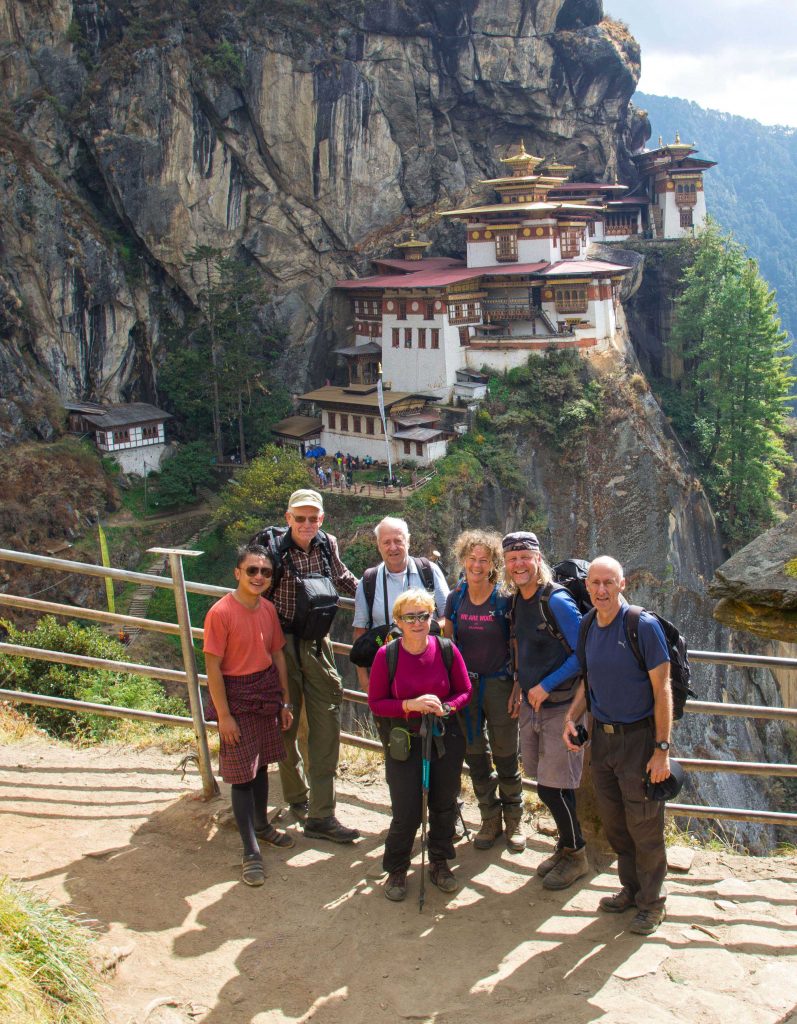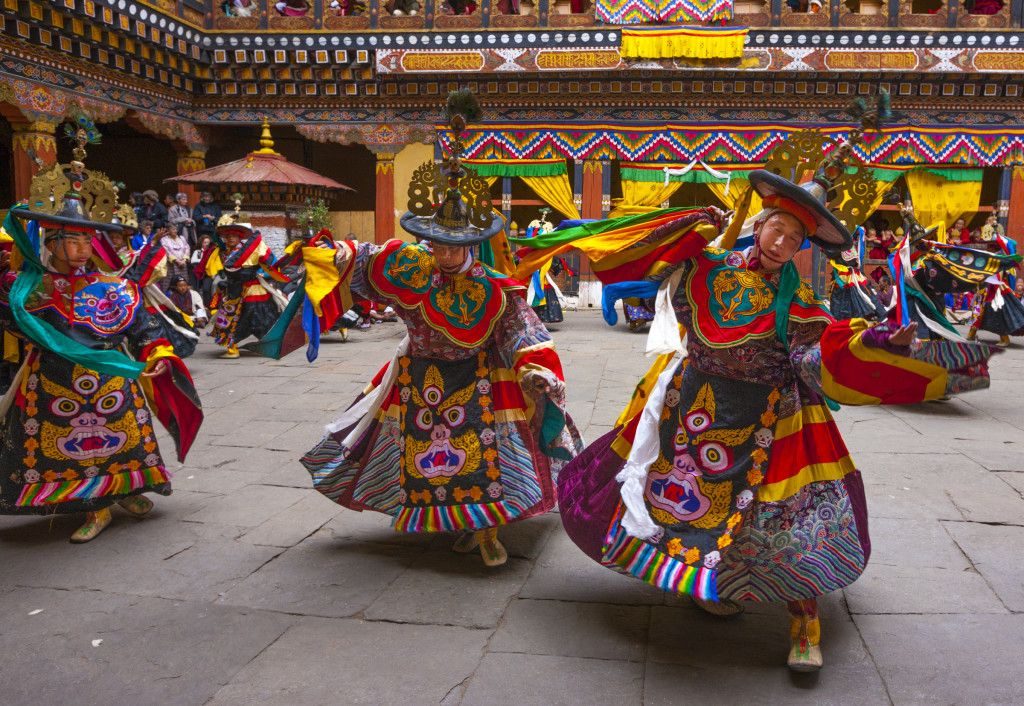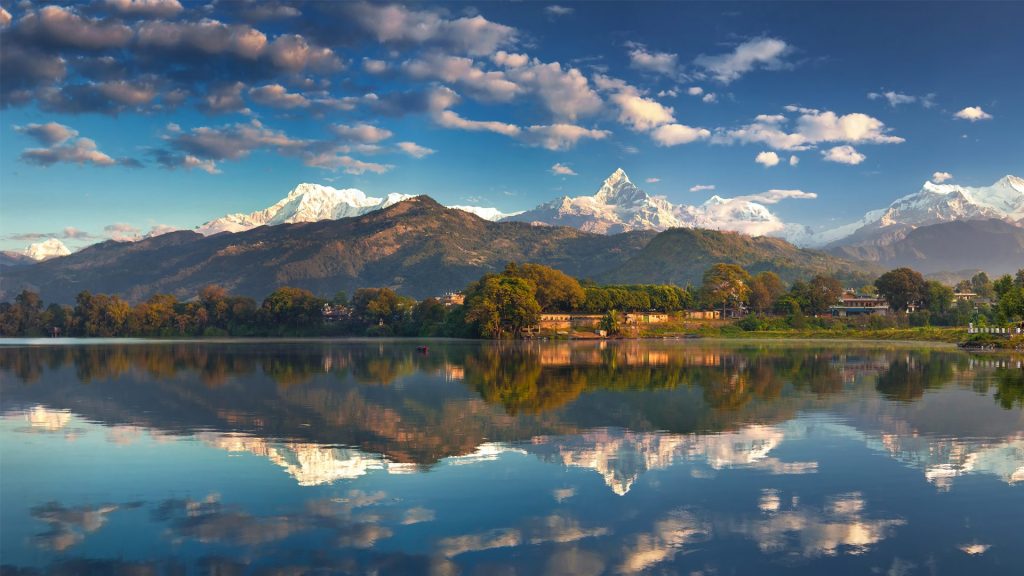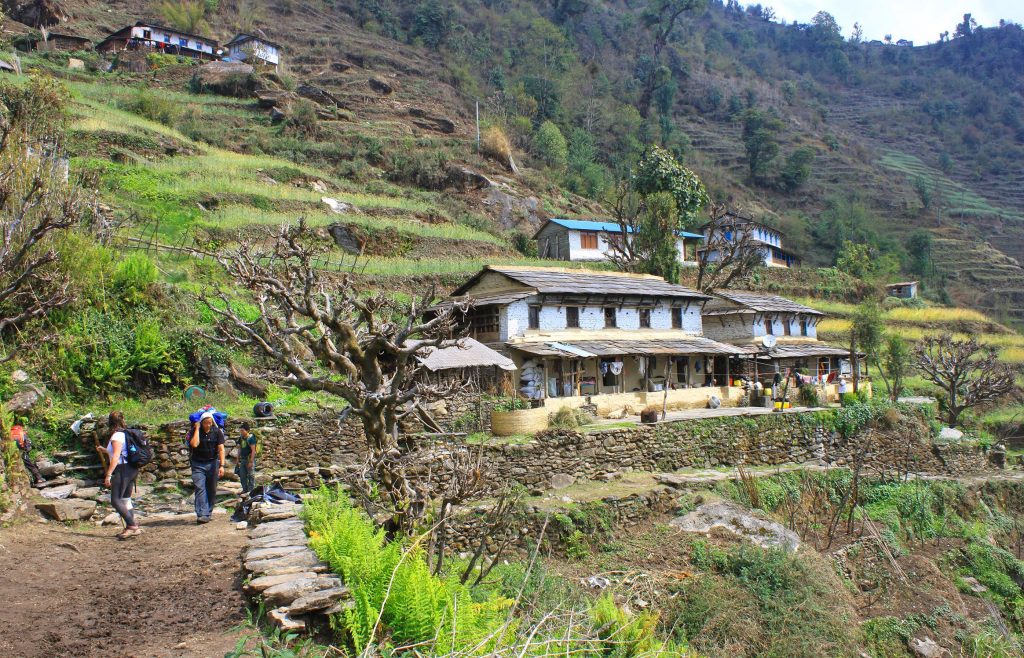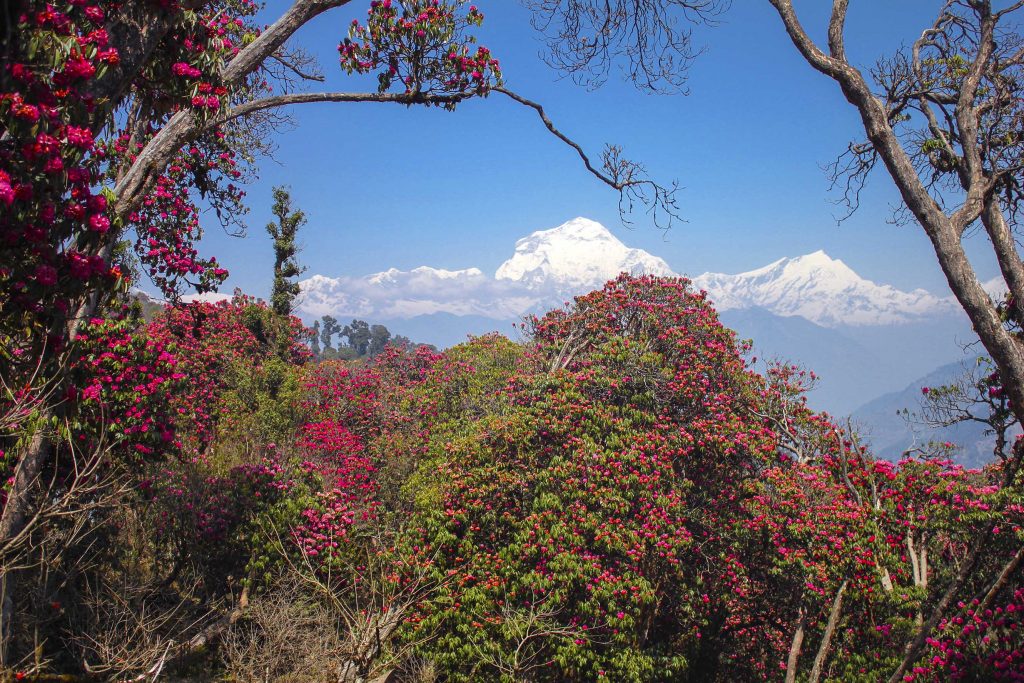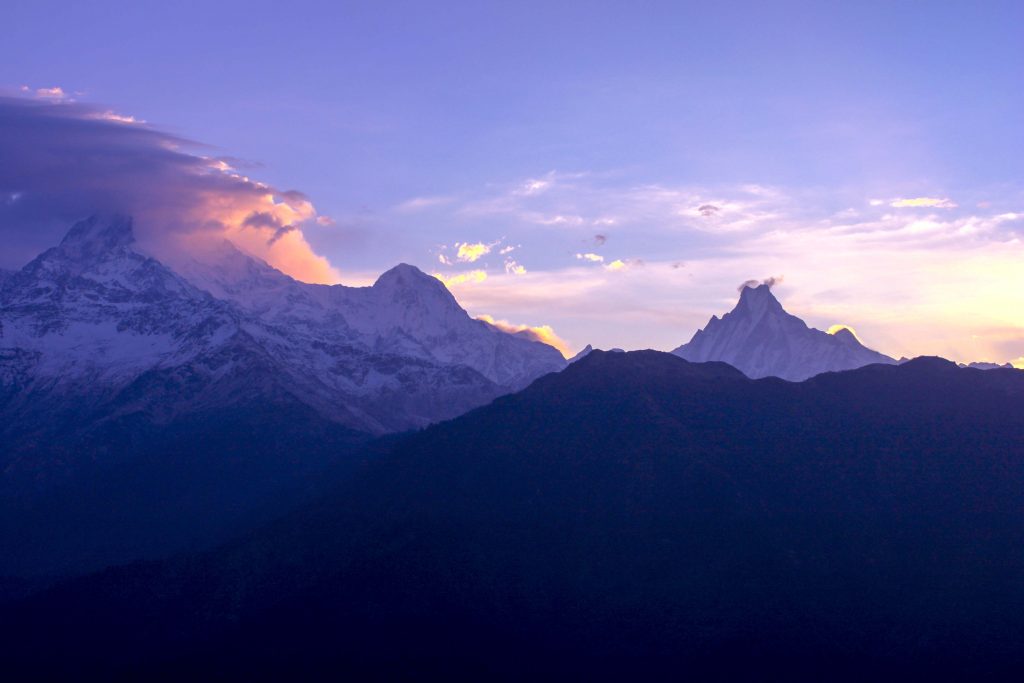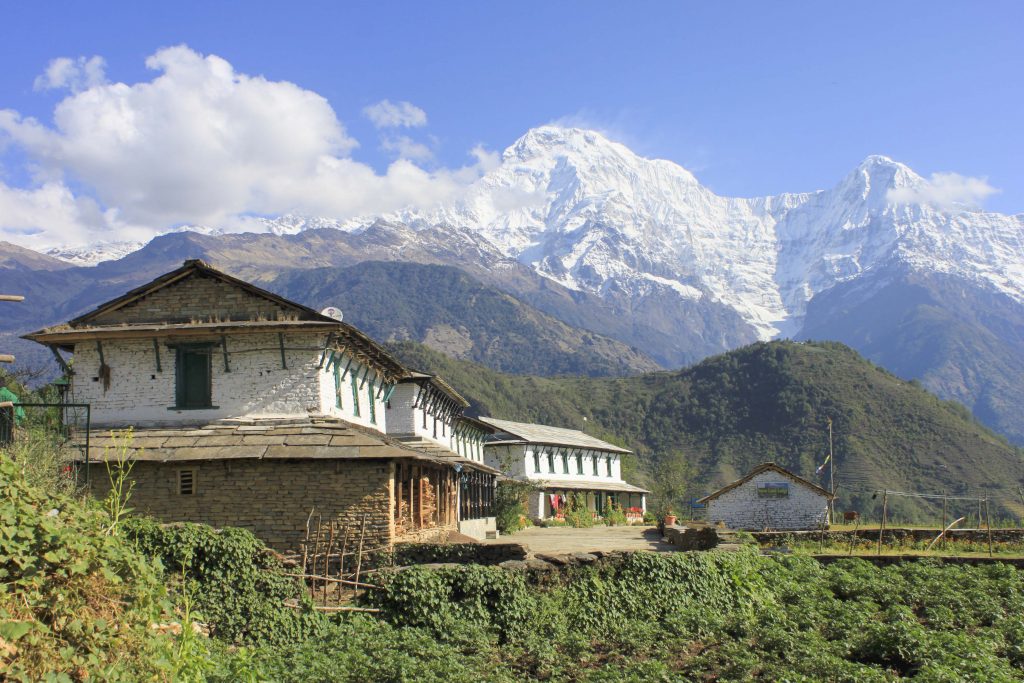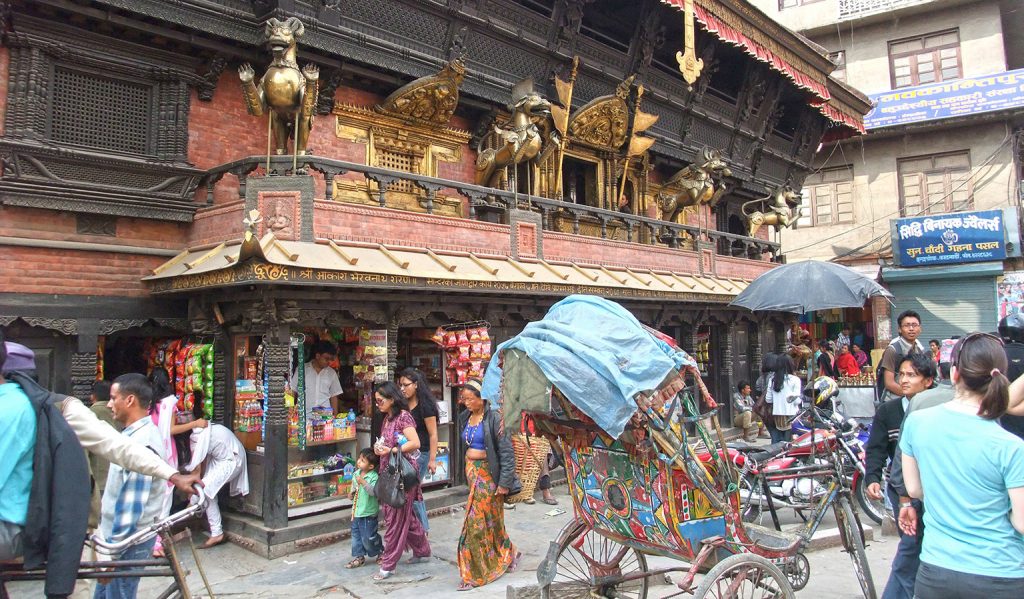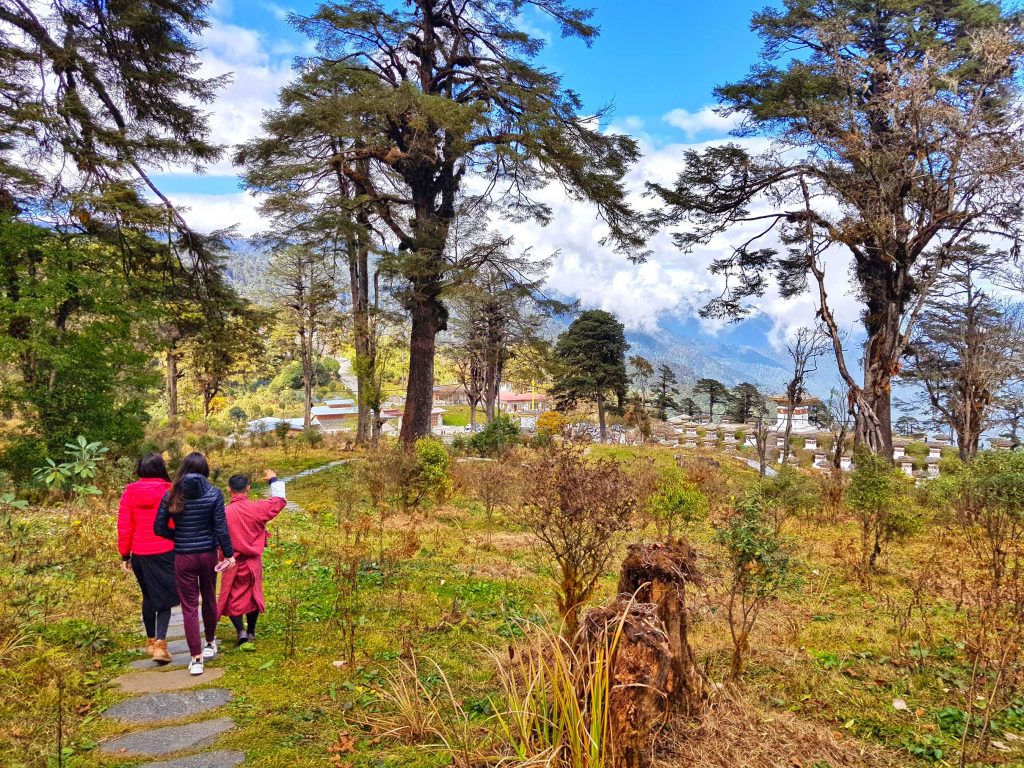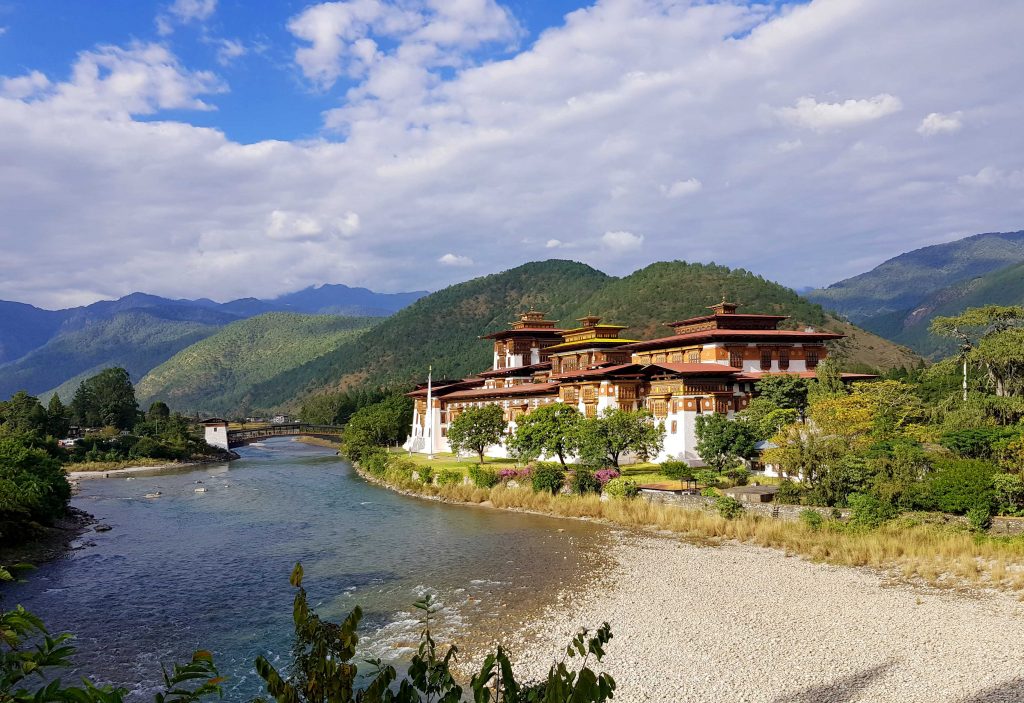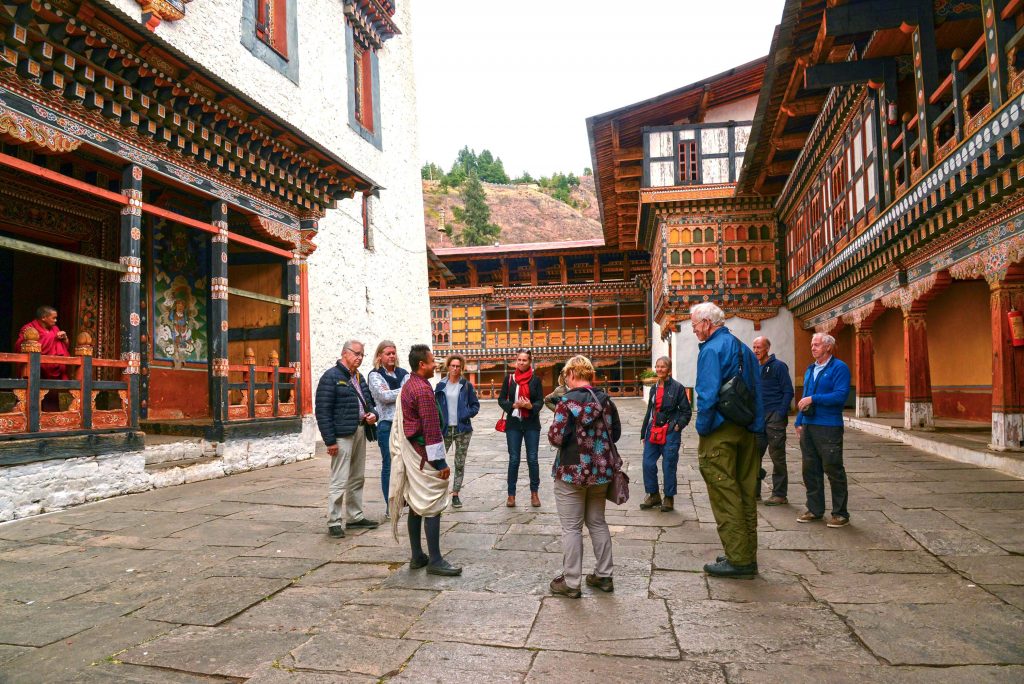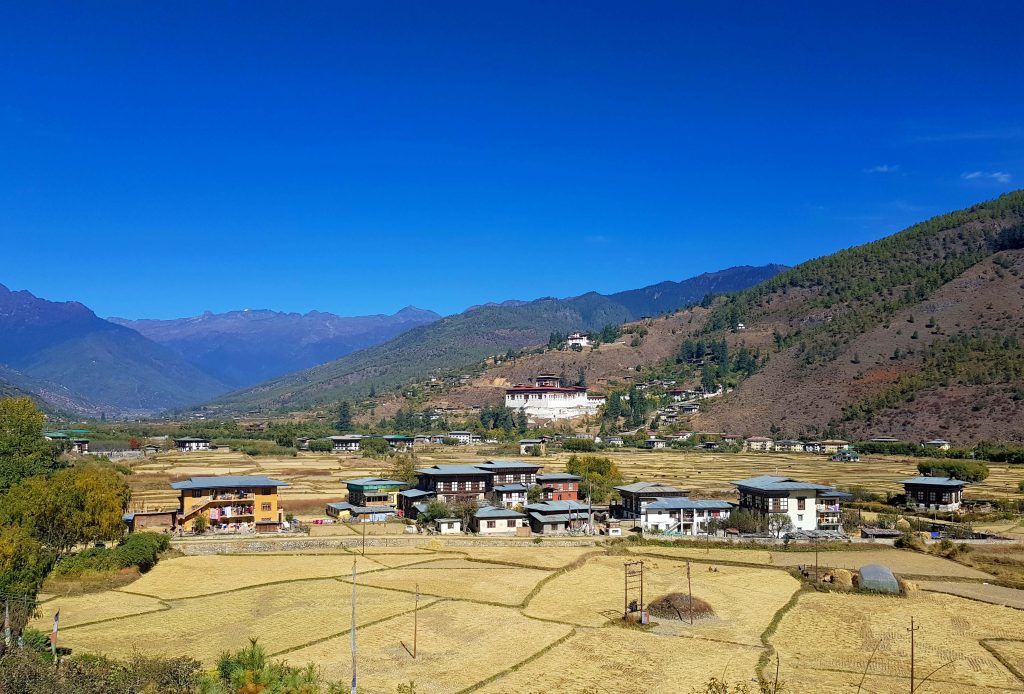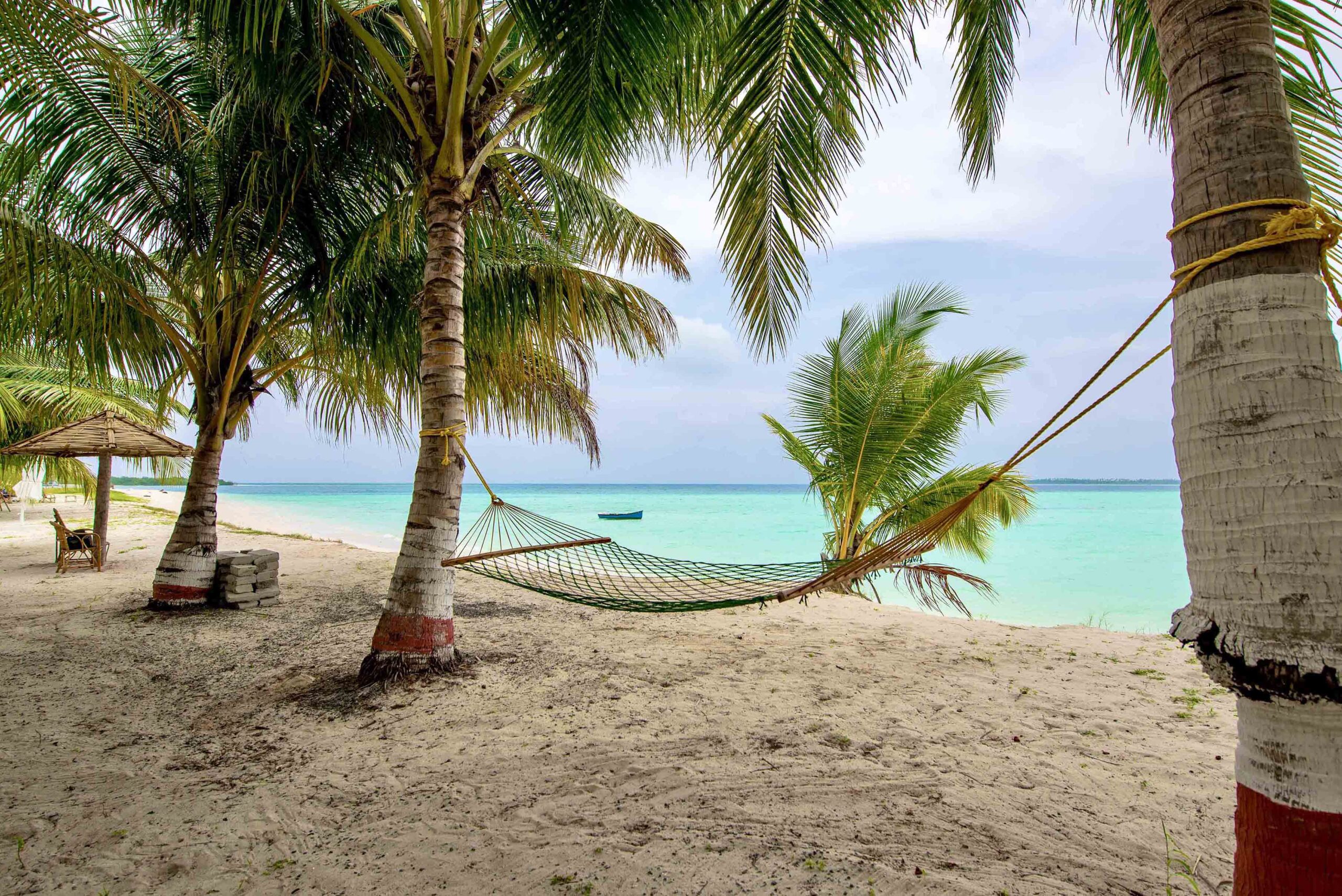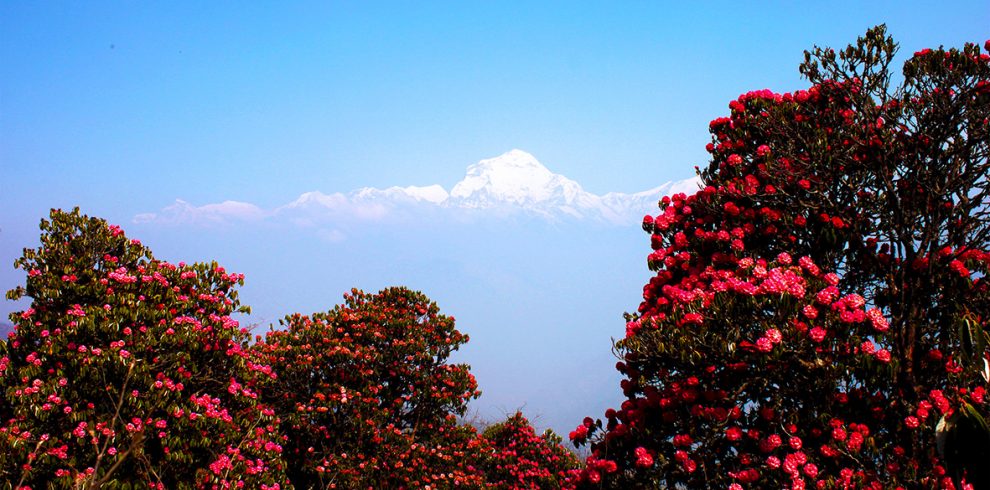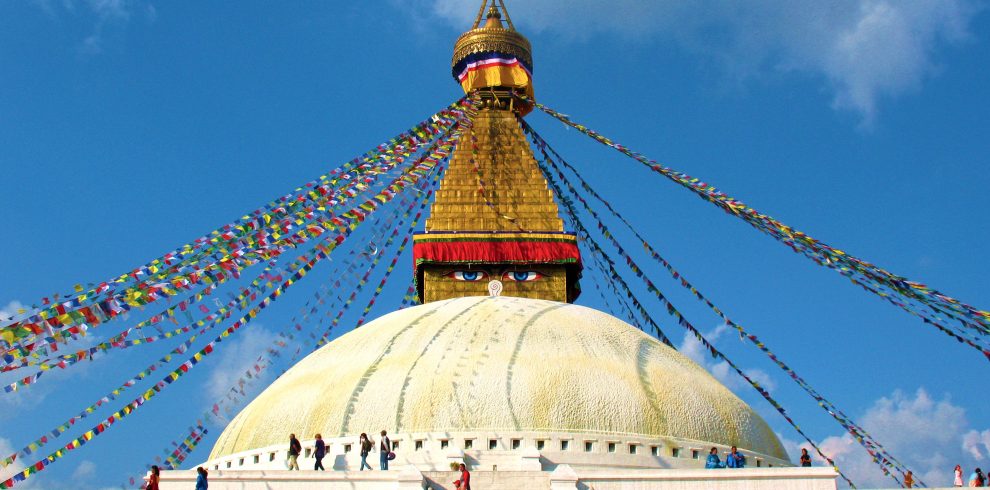This trip is a perfect combination of two of the best regions in the Himalaya. Experience the colorful sights and culture of enchanting Kathmandu with its tranquil temples and sacred Buddhist sites along the jostling streets. Explore Pokhara which is the No. 1 adventure and leisure city of Nepal, known for its spectacular scenery and adventure activities. Embark on a five days of fabulous trek in the Annapurna that you’ll never forget, where the rewards far outweigh the efforts. Annapurna region is undeniably one of the most sort out destination for travelers around the world because of its magnificent mountain views, ecological and cultural diversity, ethnic villages with terraced farmland and hospitable local people. After the trek, an exciting mountain flight, flying parallel to five of the highest mountains in the world, will take you to the land of Happiness- Bhutan! Travel though the fairy tale Kingdom with its pine scented monastery crowned hills, breathtakingly beautiful country side and ancient Buddhist monasteries and Dzongs (fortress).
Overview
Bhutan, a tiny Himalayan Kingdom, never cease to amaze the world with its incredible policies which can only be a dream for most of the countries. The Bhutanese government considers that the happiness of the people is the most important thing in any decision or policy that it makes, so Gross National Happiness is more important than Gross domestic product.
Bhutan is the only country in the world where its citizens have constitution obligation to protect their environment, which means 60% of the nation have to stay forest. It is the only country in the world to be carbon negative.
Bhutan regulates tobacco and tobacco products, banning the cultivation, harvesting, production, and sale of tobacco and tobacco products in the country. However in 2012, Parliament passed urgent amendments with the effect of greatly increasing permissible amounts of tobacco and reducing penalties, although sale and distribution remain prohibited.
Although a small country, and considered as the least developed country in Asia, it actually comes 1st in economic freedom and ease of doing business and peace and ranks 2nd highest in per capita income in all of south east Asian countries. It is indeed the Happiest country in the world!
No wonder Bhutan has become the favorite vacationing destination for celebrities!
Some of the celebrities who have vacationed in Bhutan– Prince William and Kate Middleton (Duke and Duchess of Cambridge), Their Majesties The King and Queen of Sweden, politician Aung San Suu Kyi to Hollywood superstars like Brad Pitt, Richard Gere, Keanu Reeves, Drew Barrymore, Leonardo DiCaprio, Mick Jager, Justin Timberlake, Cher, Michael J Fox , Cameron Diaz, Bryan Adams, K.D. Lang, Demi Moore, Sting, Jennifer Lopez, Uma Thurman, Steven Seagel , Micheall Yeow, Eva Mendes, Nathalie Kelley, Emma Stone and Andrew Garfield, Emily Blunt and John Hoskins, Ricki Martin, Jet Li, and South East Asian celebrities like Charm Reya Osthanond, Kathryn Bernardo, Daniel Padilla, Khalil Ramos, Enrique Gil, Xiong Naijin, Gretchen Barretto, Martinez, Tony Leung, Carina Lau and many more.
Highlights
- Explore Kathmandu city with its ancient Hindu and Buddhist temples
- Explore Pokhara- known for its spectacular scenery and adventure activities
- Mountain flight to Bhutan- You can see 5 of the world's 6 highest mountains viz. Mt. Everest, Mt. Kanchendzonga, Mt, Lhotse, Mt Makalu, and Mt Cho Oyu
- 5 days 6 nights tour of Bhutan
Itinerary
Elevation of Kathmandu: 1340m
Once you reach KTM airport and finish with the immigration and custom formalities be prepared to confront the confusion outside the airport which is common in most of the south Asian countries. As you walk out of the Exit door into the passenger pick up area you will see hundreds of people with different sign boards in their hands, taxi drivers looking for fares, hotel touts looking for customers and porters trying to help with the luggage for tips. Please remain calm and do not walk out of the restricted area into the crowd straight away. Remain there and try to find the Hi On Life sign board. Once you spot it, walk straight to the signboard and identify yourself. From here we will take care of you. When you arrive to your hotel you will be briefed about your activities and “do’s and don’ts” while your stay in Kathmandu. We will also collect some documents from you. Please have the following things handy when arriving.
Travel/ Medical Insurance (photo copy)
2 passport size photos
Photocopy of your passport.
In the evening we will go for a traditional Nepali dinner at Kathmandu’s finest Nepali restaurant.
Kathmandu, the capital city of Nepal was once thought to be the fabled and inaccessible Shangri-La. It is now a hub for independent travelers as well as a growing vacation spot catering to all budgets. The city with a population of 2.5 million stands at an elevation of approximately 1,400 meters (4,600 ft) in the bowl-shaped Kathmandu Valley of central Nepal. It is surrounded by four major hills: Shivapuri, Phulchoki, Nagarjun, and Chandragiri. Kathmandu was ranked third among the top 10 travel destinations on the rise in the world by TripAdvisor and ranked first in Asia.
Flight Kathmandu to Pokhara: 30 mins
Elevation of Pokhara: 890m
We depart from the hotel early in the morning and are transferred to the domestic terminal at Kathmandu airport. From here we fly to Pokhara, which is a spectacular flight, flying west,
parallel to the mountain range with a flight time of about 30 minutes. After arrival at Pokhara we will be transferred to our hotel in the heart of Lakeside.
Pokhara is the second largest city in Nepal. With spectacular scenery, adventure activities, and accommodation and food choices galore, Pokhara is Nepal’s number 1 adventure and leisure city. Pokhara is well-known as a starting point for various trekking trail and expeditions in the Annapurna making it a favorite hub where travelers and adventure lovers from around the world meet. Other than being famous for being a starting point of some of the best treks in the world, Pokhara also offers adrenaline activities such as ultralight flying, paragliding, skydiving, ziplining, bungee jumping, rafting and kayaking. There are plenty of souvenir shops.
In the evening you can eat at the restaurants along the lakeside where you can meet travelers from around the world. Recommendations- The Olive Café, Moondance, OR2K, Roadhouse Café etc. Your Group Leader will arrange a dinner at one of these fantastic restaurants.
Drive Pokhara airport to Nayapul: 42 km, 1 hour 30 mins
Elevation of Nayapul: 1100m
Elevation of Ulleri: 1960m
Trek Nayapul to Ulleri: 10 kms, 3 to 4 hours approx.
From Pokhara we drive to Nayapul, and start our trek. We need to make entries of our permits and register trekkers details at the Birethani check post which is just about km from Nayapul. After completing entry formalities, we begin our trek. The first half of the trek is along the river side on undulating path. We will stop for lunch at Tikhedhunga. After lunch it is a steady climb on stone stair case for about an hour and a half to Ulleri. Ulleri is a small village with lodges and few local houses.
Trek Nayapul to Ulleri: 6 kms, 3 hours approx.
Elevation of Ghorepani: 2870m
Today the trail is mostly a climb on stone staircase through a forest. As we climb up the vegetation changes to more semi alpine with rhododendron, juniper and birch trees. Upon arrival at Ghorepani, we check into our lodge and have lunch. After lunch, you are free to explore the town.
Ghorepani used to be a rest stop where ancient traders found water (pani in Nepali) for their horses (ghora in Nepali), thus leading to the nomenclature Ghorepani. Today it is a bustling town with many lodges, souvenir shops, bakery cafes, a school a health post. The main income source for residents of the village is now tourism.
Ghorepani - Poonhill- Ghorepani: 3 km, 1 hour 30 mins + 45 mins to 1 hour stop for sunrise view
Elevation of Poonhill: 3200m
Trek Ghorepani to Tadapani: 6 kms, 3 to 4 hours approx.
Elevation of Tadapani: 2700m
Today we wake up very early, and after a cup of tea, climb the well trodden stony steps up to Poon Hill. It takes us about 1 hour to reach the top and from here we get spectacular sunrise views of the Annapurnas and Dhaulagiri. After spending about an hour here we go back down to Ghorepani. There is no Yoga practice this morning as we do want to reach our destination in daylight so after packing your bags, we eat breakfast and hit the trail. From Ghorepani we retrace our steps back to Tadopani, along the ridges, stony steps and through dense forest. It is a beautiful and tranquil walk.
Trek to Ghandruk: 6 kms, 3 hours approx.
Elevation of Ghandruk: 1950m
After breakfast we begin our walk along the ridge and through a rhododendron forest. The walk is fairly easy and very beautiful with little streams and a whole new feel to the trek. It is one of the
most peaceful days of walking and after a couple of hours through the forest we reach Kymrong Danda. There are a few lodges here and we have lunch. From here we descend to Ghandruk an
ethnic Gurung Village. We settle into our accommodation and the afternoon is free with lot’s to do and see. The carpet and handicraft factory, run by the Ama’s group (mother’s self-help
group) is worth visiting. The ACAP headquarters show a documentary about the Annapurna area and issues regarding local conservation, which is also worth viewing.
Trek to Khimche: 2 kms, 45 mins approx.
Drive to Pokhara: 50 kms
From Ghandruk the trail and descends about 300 m on stone staircase to Khimche. From here we will take a jeep to Nayapul which is an off road road drive for 7 kms. At Nayapul, our van will be waiting for us to drive us to Pokhara.
Upon arrival at Pokhara, we will check in to our hotel. The rest of the afternoon is free for you to explore Pokhara at leisure.
Flight Pokhara to Kathmandu: 30 mins
We will fly to Kathmandu in the morning. Upon arrival to Kathmandu we will check in to our hotel. After lunch we will have a sightseeing tour around the city.
Places you will visit:
Boudhanath Stupa: It is the largest stupa in Nepal and the holiest Tibetan Buddhist temple outside Tibet.
Kathmandu Durbar Square: Commonly called Basantapur Darbar is one of three Durbar (royal palace) Squares in the Kathmandu Valley in Nepal, all of which are UNESCO World Heritage Sites.
Durbar Square was surrounded with spectacular architecture that showed the skills of the Newar artists and craftsmen over several centuries, but several buildings in the Square collapsed due to a major earthquake on 25 April 2015.
Flight Kathmandu to Paro: 1 hour 10 mins
Elevation of Paro: 2200m
The flight from Kathmandu to Paro is exceptionally beautiful flight. We fly parallel to the Himalaya passing 5 of the world's 6 highest mountains- Mt. Everest 8848m (highest), Mt. Kanchendzonga 8586m (3rd highest), Mt. Lhotse 8510m (4th highest), Mt. Makalu 8467m (5th highest) and Mt. Cho Oyu 8210m (6th highest) along with scores of 7000m peaks.
Upon arrival at Paro, you will be received by our representative at the airport and driven to your hotel. After a short break we visit the Ta Dzong or National Museum, rated among the best natural history museums in Asia. The Ta Dzong offers a unique and varied collection of Thangkas, handicrafts, stuffed animals, masks, costumes and amour and it gives a good idea of the culture and traditions of Bhutan. On the way you will also get to explore the weekend Market of Paro Valley. Later we visit, Kyichu Lhakhang, one of the oldest and most scared monastery in the country. It was built by the first Buddhist King of Tibet Songtsen Gampo in the 7th century. Then you will be driven to the ruins of Drukgyal Dzong or “fortress of the victorious Drukpas” was built in 1649. In fine weather, the towering peak of Mount Jumolhari, (7,314 m / 24,000 ft) appears as a backdrop. You will then be driven to the hotel.
In the evening we will go to farmhouse for a local welcome dinner with traditional dance shows.
Trek distance: 4 ½ kms one way
Trek: 5 hours both ways
Elevation of Tiger's Nest: 3200m
Today we hike to the most famous Taktshang, popularly known as the Tiger‟s Nest, built amazingly on a steep cliff. According to legend, Guru Padmasambhava flew here on a flying Tigress and meditated there for three months in the 8th century. It was from there, he propagated the Vajrayana- Mahayana Buddhism (Larger Wheel) that was prophesied by the Buddha at the time of attaining Nirvana. The walk uphill takes you a little more than 300m above the Paro valley. It is a great pilgrimage destination for devout Buddhists. The main deity of Taktsang is Dorji Drolo, the wrathful form of Guru Rinpoche, (the precious teacher). There are 13 sacred sites at Taktsang, and several meditation caves in the cliffs above. Many saints are said to have meditated here. The return walking time is approximately one hour. Towards evening after the hike we will enjoy the Bhutanese Traditional Hot Stone Bath which uses river rocks that therapists place in water where they crack and steam, releasing key minerals and relieving deep-set aches) followed by dinner which in a local farm house with local family where they will serve typical Bhutanese dishes.
Tiger's Nest Monastery
Distance: 126 kms
Drive: 4 hours
Elevation of Punakha: 1242m
After breakfast, drive to Punakha. The road climbs from Thimphu to Dochula pass and descends through ever changing forests into the semi-tropical valley of Punakha and Wangdi at around 1200m. En-route stop at Dochula pass (3050m) where you can view the eastern Himalayas, including Bhutan’s highest mountain, Gangkar Punsum (7,550m).
Punakha is located at about 1,250m with pleasant winters. Cactuses, Oranges, bananas and sub-tropical plants are found here. Punakha was once the winter capital of Bhutan, the tradition that is still held by the Central Monastic body.
Upon arrival, we visit Punakha Dzong, “Palace of Great Happiness”, which is located on the confluence of two rivers; Pho and Mochu was built in 1637 by Shubdrung Nawang Namgyal. It serves as winter residence for the Central Monastic body, which migrate from Thimphu to Punakha in the winter. It is also the venue for Punakha Festival held in February or March.
Fertility Temple (Chimi Lhakhang): a monastery and fertility temple dedicated to Lama Drukpa Kuenley, a Tibetan Buddhist saint known popularly as “the divine madman” and considered a folk hero in Bhutan for his unconventional ways. Drukpa Kuenley originally built a chorten on the site in the 14th century, on which a temple was later built in 15th century. The temple, flanked by nearly 100 tall prayer flags, sits atop a picturesque hill. It has long been a pilgrimage site for childless couples. This easy walk takes about ½ hour each way.
Distance: 85 Kms
Drive: 2 ½ hours
Elevation of Thimpu: 2335m
Thimpu is the capital city of Bhutan, and is home to approximately 100,000 inhabitants including the Royal family. This bustling little city is the main centre of commerce, religion and government in the country. Thimphu is a modern city with an abundance of restaurants, internet cafes, nightclubs and shopping centres. However, it still retains its’ cultural identity and values amidst the signs of modernization.
The subtle combination of ancient tradition and modernity make Thimphu the ideal location for visitors to break away from their tour itinerary to immerse themselves in the contemporary Bhutanese lifestyle.
Today you all will enjoy full day Local sightseeing at Thimphu includes visit to the National Memorial Chorten, (a stupa dedicated to world peace), a shrine built in 1974 in memory of the Third King of Bhutan dedicated for world peace and prosperity followed by the visit to the School of Arts and Crafts (National Institute of Zorig Chusum) where students undergo training course in Bhutan’s 13 traditional arts and crafts; the National Institute of Traditional Medicine where Bhutan’s famed traditional medicines are compounded and dispensed; the Folk Heritage Museum which will provide an insight into traditional Bhutanese farm house and rural past through exhibits and documentation of rural life.
After lunch, visit the Textile Museum to see a range of beautiful Bhutanese textiles and then Changangkha Lhakhang, a fortress like temple which lies perched on a ridge above Thimphu; Takin Preserve to see the rare national animal of Bhutan. This animal is chosen as the national animal of Bhutan for its uniqueness and its association with the country’s religious history and mythology. A further drive towards the BBS Tower will provide a bird eye view of the capital. Also visit a small family-run enterprise which manufactures paper and paper products using traditional methods followed by visit to Tashichhodzong or the “fortress of the glorious religion” which is Bhutan’s administrative and religious centre and houses the throne room of His Majesty the King of Bhutan, other Government offices. It is also the summer residence of Je Khenpo or Chief Abbot.
Your guide in Bhutan at the Buddha point, Thimpu.
Distance Thimpu to Paro: 50 kms
Drive: 1 hour 15 mins
Flight Paro to Kathmandu: 1 hour 10 mins
Early morning drive to Paro airport and fly to Kathmandu. Upon arrival at Kathmandu we will check in to our hotel. The rest of the afternoon is free to explore Kathmandu at leisure.
We will drive you to Tribhuwan International airport about 3 ½ hours before your departure time.
Cost Includes
- For Kathamandu
- Airport arrivals and departures and all internal transportation in Kathmandu as per program in private tourist vehicle.
- Welcome dinner
- English speaking guide
- 3 nights hotel accommodation with breakfast on twin share while in Kathmandu .
- ½ day guided city tour in Kathmandu by private tourist vehicle including lunch.
- Return airfares Kathmandu/ Pokhara/ Kathmandu.
- 2 nights hotel accommodation with breakfast on twin share at Hotel Barahi while in Pokhara
- All meals while in Pokhara in selective restaurants (lunch and dinner)
- 5 day Ghorepani Poonhill trekking with all meals (breakast, lunch and dinner)
- Accommodation on twin share in lodges while on trek
- Afternoon tea/ coffee with snacks upon arrival at the lodge
- Use of a personal trek pack, consisting of: Duffel bag, down jacket and sleeping bag with inner-liner.
- Services or porters and Sherpas
- Annapurna conservation fees and permit
- Trekkers Information Management fees
- Staff insurance
- Government fees
- For Bhutan
- Return Airfares Kathmandu/ Paro/ Kathmandu.
- Bhutan visa fees and processing fees
- Government royalty
- All internal transportation in Bhutan in private tourist vehicle.
- Welcome dinner with traditional folk dances at a local farmhouse
- Accommodation in Paro at Mandala Resort or equivalent
- Accommodation in Punakaha at Meri Puensum resort or equivalent in Punakha
- Accommodation in Thimpu at The Druk Hotel or similar
- All meals during the trip (breakfast, lunch, dinner and tea & snacks)
- Licensed English-speaking Bhutanese tour guide.
- Monument and museums entrance fees for all sightseeing locations detailed in the itinerary.
- All government taxes, official expenses and tourist service charges.
Cost Excludes
- Personal accident and rescue insurance. You must provide your own rescue insurance
- Mineral water, beer, soft drinks and extra tea/coffee outside of normal meal times.
- Private room accommodation unless a single supplement is paid.
- Optional tips to guides and porters.
- Nepal Visa
- Helicopter evacuation in the unlikely situation, although we do arrange for it and make the necessary documents so that you can claim from your insurance.
- PS- All hotels on this trip are 3 star and 4 star category. If you wish to upgrade it to 5 star hotels, please mention at the time of booking.
About Nepal
Nepal, a tiny country, nestled in the Himalayas between India and China, is one of the most diverse and fascinating countries in the world. Covering an area of only 147,181 sq. km, Nepal encompasses the world’s highest mountains and the deepest valleys as well as low elevation rain forest. Although the width of the country is only 200Km North to South, Nepal has the highest altitude variation of any country on earth, from 20m above sea level to 8848m above sea level (Top of Everest).The country is divided in to 3 elevation Zones viz. the low Terrain, the midhill region and the high Himalayas, which contains 1/3 of the Himalayan range with 9 of the world’s highest mountains. This wide diversity of landform gives Nepal an incredible wealth of flora and fauna. Nepal is not only famous for its landscape but also renowned for the friendliness of its people.
The people of Nepal are as variable and intriguing as the country’s geography. There are more than 37 ethnic groups with their own language and culture. Hinduism is the official religion, which the majority of the people practice. Many people throughout the country are Buddhist and the two religions have co-existed in harmony over the ages. A small number of people practice Christianity and Islam. In 2016- Nepal has been listed as the No 1 travel destination in the world!
Nepal at a glance:
- Longitude: 26’12’ North to 30’27’ NorthLatitude: 80 degree 4′ East to 88 degree 12′ East
- Population: 24 million
- Capitol: Kathmandu Area: 147,181 sq. km.
About Bhutan
Bhutan , officially the Kingdom of Bhutan, is a landlocked country in the eastern end of Himalayas, between the Tibet Autonomous Region of China and India. Bhutan’s landscape ranges from heavily forested foothills and subtropical plains in the south and a rugged and mountainous landscape with snow-capped peaks and glacier covered terrain in the north, where some peaks exceed 7,000.
Besides the stunning natural scenery, Bhutan is known for her strong sense of culture and tradition that binds the kingdom. Perched high in the Himalayas, it is the world’s last remaining Buddhist Kingdom and the only Vajrayana Buddhist nation in the world. The profound teachings of this tradition remain well preserved and exert a strong influence in all aspects of life. Due to its pristine environment and harmonious society, the tiny Kingdom of Bhutan has been called “The Last Shangrila.”
It has developed the philosophy of Gross National Happiness, where development is measured using a holistic approach of well-being, not just based on gross domestic product. The Government of Bhutan provides free education and, though rudimentary, free medical care to its citizen. The sale of tobacco products is banned and smoking in public areas is a fine able offense.
In 2008, Bhutan made the transition from absolute monarchy to constitutional monarchy and held its first general election. Major sources of income are tourism, hydroelectric power and agriculture. Bhutan has long maintained a policy of strict isolationism and only a limited number of tourists are allowed each year.
Bhutan at a glance:
- Area: 38,394 km2
- Population: 742,737
- Capital: Thimphu
- Currencies: Bhutanese ngultrum, Indian rupee
- Official language: Dzongkha Language
- Government: Unitary state, Constitutional monarchy, Parliamentary system
A Day on Your Trek
Although each day is different, considering the weather, general pace of the group and length of the days walk, in general your day begins with a wake up tea at around 6 to 6:30 in the morning. You will then be provided with a bowl of warm water for washing. Then you will need to pack your duffel bag and your daypack and come to the lodge’s diner for breakfast.
After breakfast we will hit the trail and usually walk for about 3 to 4 hours before we stop for lunch. We will give you about an hour and a half rest during lunch, which will also give enough time for the staff to have their lunch and pack. Usually after 3 to 4 hours of walking we finish the days walk by 4 PM. Tea/ Coffee and snacks will be served on arrival to the lodge. Your group Leader will often organize side trips in the afternoon. Your dinner will be served around 7 PM.
Staff
Group leader: your most important member of your staff. Our Group leaders are highly trained in all aspects of the trek, conservation, first aid specializing on altitude sickness, emergency procedures and have extensive knowledge of the natural history of the area.
Sherpas: Their job is to lead your way and distribute equal loads to the porters.
Porters: They are responsible to transport your duffel bags and their job finishes once they reach the designated lodge. Our porters are provided with Gore-Tex suits, trekking boots, gloves, hats, socks, snow gaiters and snow goggles. Most importantly, we regulate them on a 25 Kg carrying which no other company does. Our clients can therefore feel comfortable knowing that our porters are working in a good humane condition. During the trek you can see porters carrying 60-70 kg and sometimes even more than 100 kg!!)
Weather:
Oct/Nov and March/April
On the trek at lower altitude (2500m to 3500m) during daytime the Max temp can be around 15C to 20C and the Min temp can be 0C to 5C
It is generally clear in the morning with afternoon intermittent cloud.
This is general information and it could vary.
Recommendations for things you should bring:
Clothing:
Head:
- Warm hat wool or synthetic that covers your ears
- Sunhat
- UV shield/ Category 2 sunglasses
- Headlamp with extra batteries
- Bandana or head scarf, also useful for dusty conditions
Upper Body:
- 2 cotton t-shirts or long sleeve shirt for city wear
- 2 polypropylene or wool mix t-shirts
- 1 polypropylene or wool mix long sleeve t-shirts
- 1 long sleeve thermal underwear shirts, lightweight preferably woolen
- 1 polar fleece jacket, OR Primaloft/ Down light weight jacket
- Gore-Tex jacket with hood, waterproof and breathable
- For high altitude use, 1 very warm goose-down jacket with hood (we provide this)
Hands:
- 1 pair light weight wind stopper gloves
Lower Body:
- 1 pair walking shorts
- 1 pair walking trousers for trekking
- 1 to 2 pair trouser/ skirt for city wear
- 1 pair stretchable running trouser for evening wear at lodges
- 1 pair lightweight thermal bottoms
Feet:
- 1 pair trekking /walking boots with good ankle support
- 1 pair trainers, running shoes and/or sandals for city wear and in lodges;
- 2 pair med weight preferably wool socks
- 2 to 3 pair of liner socks. Polypropylene or wool
- 1 pair lightweight trekking socks, poly or wool
Sleeping:
We provide:
- 1 down sleeping bag (rated to – 20 Centigrade or -0 F )
- 1 polar fleece liner
For every trek we provide these 1400 gm to 1800 gm down sleeping bags depending on altitude, and down jackets
Rucksack and Travel Bags:
- 1 medium rucksack (20-25 litres)
- We provide you 1 big duffle bags.
- Small padlocks for duffel kit bags.
Assesories:
- 1 small roll of repair tape, 1 sewing repair kit
- Camera
- Nylon stuff sacks for food and gear storage, large Ziplocs are useful also
- 2 Water bottles (1 litre)
- 1 small folding knife
- Books, playing cards, ipod/mp3 player, games, small musical intruments
- Adequate amount of batteries, etc.
Health and trouble free holiday
There are no compulsory vaccinations required for entering Nepal. However please consult a doctor for vaccination against Typhoid, Meningitis, polio, and hepatitis. If you have special dietary requirements or allergies, please through your agent, give us a list of what you can and can’t eat so that we can provide proper food for you.
If you are undergoing a course of prescription medicine, please ensure that you have sufficient supplies for the entire holiday. Some types of drugs including antimalarials have side effects at high altitude; therefore please consult your doctors regarding these drugs. The places you trek are mosquito free and there has been no report on malaria in Kathmandu for the past couple of decades.
Insure yourself
We highly recommend you to take a comprehensive Personal Travel Insurance before leaving home. This should cover for your loss of baggage, airline delays, sickness and accidents. And it should also cover you for Emergency Helicopter Evacuation.
Money Matters
The ideal currency to bring with you is USD.
In Kathmandu: Each meal will cost around 4 to 6 USD. Plus 10 to 20 USD for your taxis if you wish to go around the city.
On trek: You will need around 6 to 10 USD per day. This money is for your hot showers, chocolates, soft drinks and beers etc and also for small donations in the monasteries.
Tipping
Although tipping is entirely optional and personal matter the following is recommended as a guideline
In Kathmandu: for bellboys, waiters and porters 50 to 100 Nepali Rupees
For the trip: We will collect the tip at the beginning of the trip so that you dont need to keep arranging money for the tips for different places. From this pot we will give tips to he driver, the trekking staff, your guide in Bhutan.
The recommended amount for the entire trip is 120 to 150 USD/ person
Some Do’s and Don’ts
Nepalese and Bhutanese people treat visitors as special guests. Although they will never rebuke you publicly for unknowingly offending them, we must consider their culture.
While in Nepal and Bhutan please observe the following:
- Full or partial nudity is not accepted
- Over display of affection between men and women, especially in temples and monasteries are discouraged
- Please remove your shoes before entering monasteries and temples
- Never point the soles of your feet at a person or shrine
- Many Hindu temples are closed to non-Hindus. Please ask before entering
- Locals walk around the Mani walls and Stupas in a clockwise direction as a respect and they expect you to do the same although it is not compulsory
- Please dress modestly while entering fort and monasteries in Bhutan. Shorts and hats are not allowed inside monasteries and forts.
- Smoking is strictly prohibited in public places in Bhutan.
“TODAY IS YOUR DAY! YOUR MOUNTAIN IS WAITING, SO… GET ON YOUR WAY!”
DR. SEUSS

